Management Accounting Report: Overhead Application and Cost Analysis
VerifiedAdded on 2022/11/13
|5
|1234
|421
Report
AI Summary
This report analyzes the overhead costs for Voltus Communication, a company that uses job costing and machine hours for overhead allocation. The report computes the applied manufacturing overhead for the period between July 1, 2018, and May 31, 2019, and for June 2019, comparing it with the actual overhead costs. It determines that the overhead was under-applied by $33,000 and recommends closing this amount to the cost of goods sold. The report also discusses the methods for disposing of under- or over-applied overhead and concludes that Activity-Based Costing (ABC) is not recommended in this scenario due to the small deviation between actual and applied overhead. Finally, the report calculates the balance in the finished goods account as of June 30, 2019, and provides relevant references.
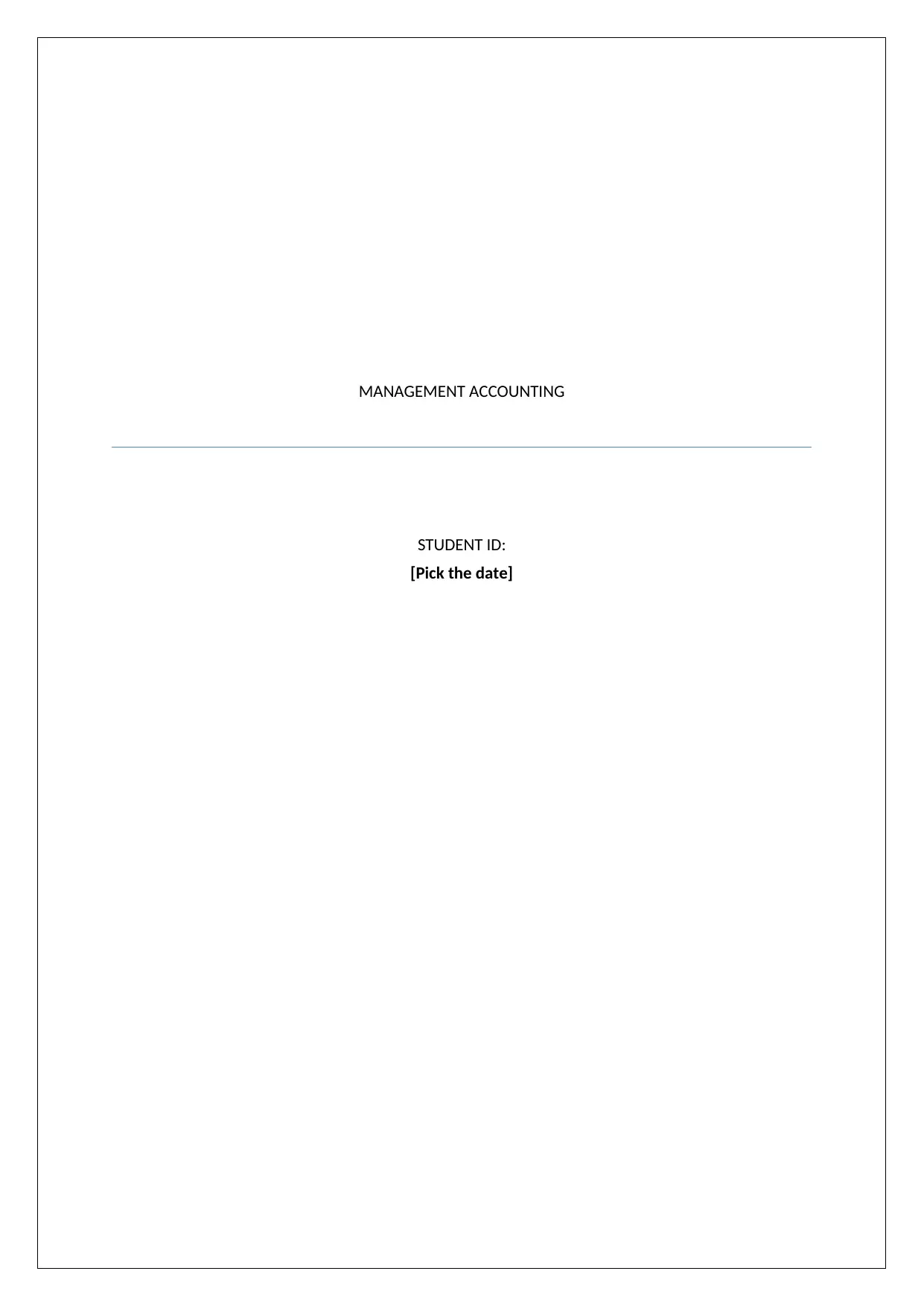
MANAGEMENT ACCOUNTING
STUDENT ID:
[Pick the date]
STUDENT ID:
[Pick the date]
Paraphrase This Document
Need a fresh take? Get an instant paraphrase of this document with our AI Paraphraser
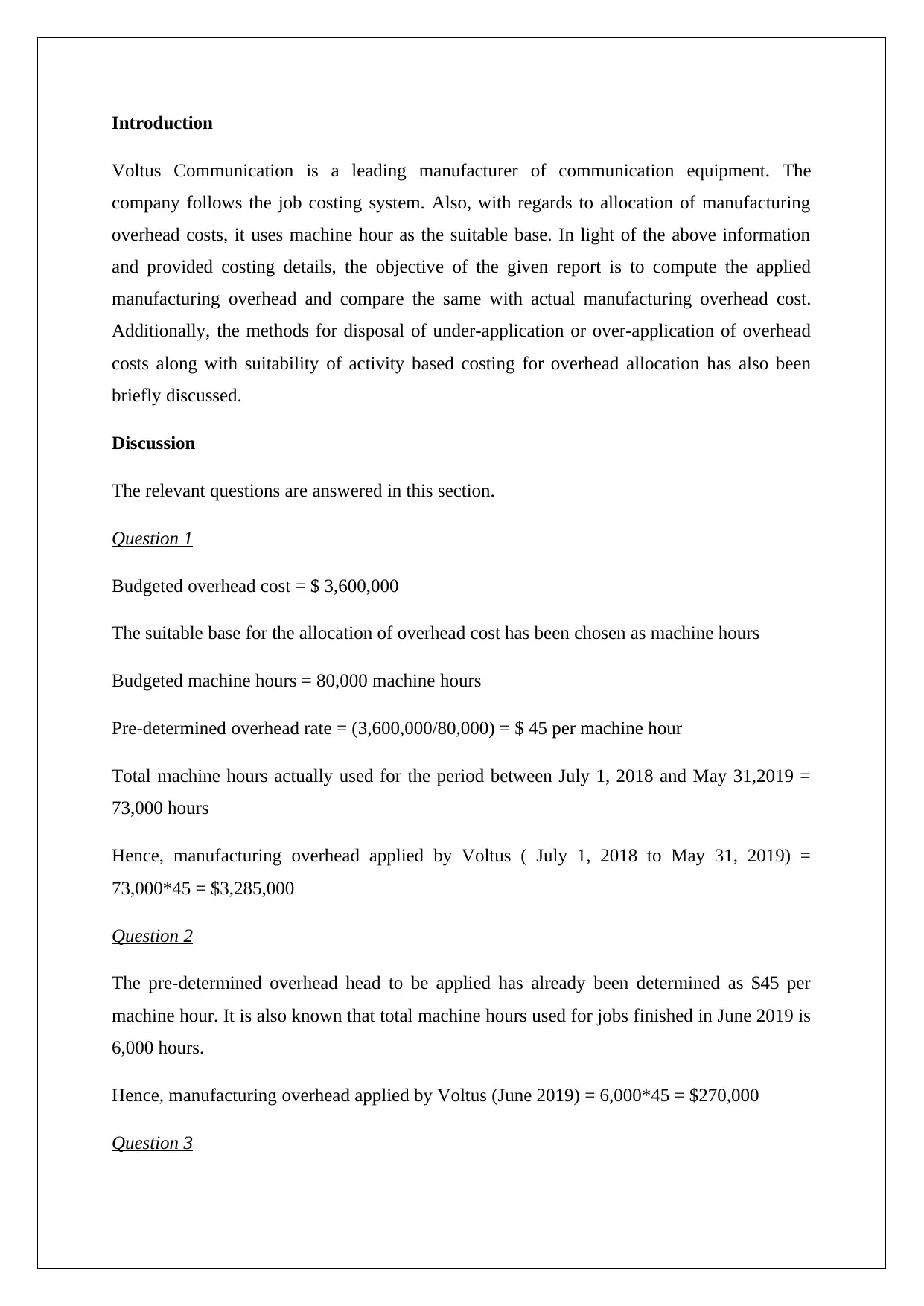
Introduction
Voltus Communication is a leading manufacturer of communication equipment. The
company follows the job costing system. Also, with regards to allocation of manufacturing
overhead costs, it uses machine hour as the suitable base. In light of the above information
and provided costing details, the objective of the given report is to compute the applied
manufacturing overhead and compare the same with actual manufacturing overhead cost.
Additionally, the methods for disposal of under-application or over-application of overhead
costs along with suitability of activity based costing for overhead allocation has also been
briefly discussed.
Discussion
The relevant questions are answered in this section.
Question 1
Budgeted overhead cost = $ 3,600,000
The suitable base for the allocation of overhead cost has been chosen as machine hours
Budgeted machine hours = 80,000 machine hours
Pre-determined overhead rate = (3,600,000/80,000) = $ 45 per machine hour
Total machine hours actually used for the period between July 1, 2018 and May 31,2019 =
73,000 hours
Hence, manufacturing overhead applied by Voltus ( July 1, 2018 to May 31, 2019) =
73,000*45 = $3,285,000
Question 2
The pre-determined overhead head to be applied has already been determined as $45 per
machine hour. It is also known that total machine hours used for jobs finished in June 2019 is
6,000 hours.
Hence, manufacturing overhead applied by Voltus (June 2019) = 6,000*45 = $270,000
Question 3
Voltus Communication is a leading manufacturer of communication equipment. The
company follows the job costing system. Also, with regards to allocation of manufacturing
overhead costs, it uses machine hour as the suitable base. In light of the above information
and provided costing details, the objective of the given report is to compute the applied
manufacturing overhead and compare the same with actual manufacturing overhead cost.
Additionally, the methods for disposal of under-application or over-application of overhead
costs along with suitability of activity based costing for overhead allocation has also been
briefly discussed.
Discussion
The relevant questions are answered in this section.
Question 1
Budgeted overhead cost = $ 3,600,000
The suitable base for the allocation of overhead cost has been chosen as machine hours
Budgeted machine hours = 80,000 machine hours
Pre-determined overhead rate = (3,600,000/80,000) = $ 45 per machine hour
Total machine hours actually used for the period between July 1, 2018 and May 31,2019 =
73,000 hours
Hence, manufacturing overhead applied by Voltus ( July 1, 2018 to May 31, 2019) =
73,000*45 = $3,285,000
Question 2
The pre-determined overhead head to be applied has already been determined as $45 per
machine hour. It is also known that total machine hours used for jobs finished in June 2019 is
6,000 hours.
Hence, manufacturing overhead applied by Voltus (June 2019) = 6,000*45 = $270,000
Question 3
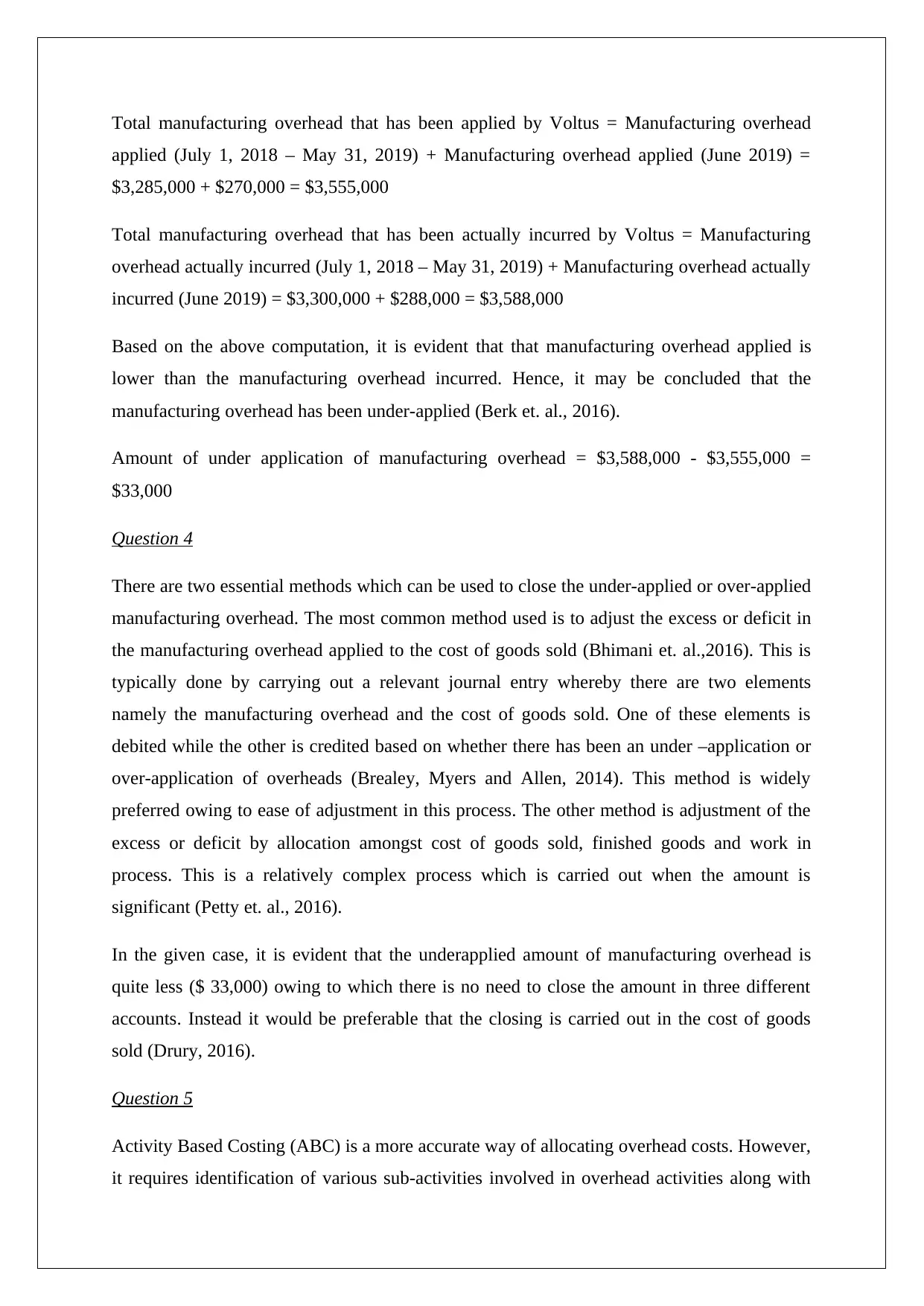
Total manufacturing overhead that has been applied by Voltus = Manufacturing overhead
applied (July 1, 2018 – May 31, 2019) + Manufacturing overhead applied (June 2019) =
$3,285,000 + $270,000 = $3,555,000
Total manufacturing overhead that has been actually incurred by Voltus = Manufacturing
overhead actually incurred (July 1, 2018 – May 31, 2019) + Manufacturing overhead actually
incurred (June 2019) = $3,300,000 + $288,000 = $3,588,000
Based on the above computation, it is evident that that manufacturing overhead applied is
lower than the manufacturing overhead incurred. Hence, it may be concluded that the
manufacturing overhead has been under-applied (Berk et. al., 2016).
Amount of under application of manufacturing overhead = $3,588,000 - $3,555,000 =
$33,000
Question 4
There are two essential methods which can be used to close the under-applied or over-applied
manufacturing overhead. The most common method used is to adjust the excess or deficit in
the manufacturing overhead applied to the cost of goods sold (Bhimani et. al.,2016). This is
typically done by carrying out a relevant journal entry whereby there are two elements
namely the manufacturing overhead and the cost of goods sold. One of these elements is
debited while the other is credited based on whether there has been an under –application or
over-application of overheads (Brealey, Myers and Allen, 2014). This method is widely
preferred owing to ease of adjustment in this process. The other method is adjustment of the
excess or deficit by allocation amongst cost of goods sold, finished goods and work in
process. This is a relatively complex process which is carried out when the amount is
significant (Petty et. al., 2016).
In the given case, it is evident that the underapplied amount of manufacturing overhead is
quite less ($ 33,000) owing to which there is no need to close the amount in three different
accounts. Instead it would be preferable that the closing is carried out in the cost of goods
sold (Drury, 2016).
Question 5
Activity Based Costing (ABC) is a more accurate way of allocating overhead costs. However,
it requires identification of various sub-activities involved in overhead activities along with
applied (July 1, 2018 – May 31, 2019) + Manufacturing overhead applied (June 2019) =
$3,285,000 + $270,000 = $3,555,000
Total manufacturing overhead that has been actually incurred by Voltus = Manufacturing
overhead actually incurred (July 1, 2018 – May 31, 2019) + Manufacturing overhead actually
incurred (June 2019) = $3,300,000 + $288,000 = $3,588,000
Based on the above computation, it is evident that that manufacturing overhead applied is
lower than the manufacturing overhead incurred. Hence, it may be concluded that the
manufacturing overhead has been under-applied (Berk et. al., 2016).
Amount of under application of manufacturing overhead = $3,588,000 - $3,555,000 =
$33,000
Question 4
There are two essential methods which can be used to close the under-applied or over-applied
manufacturing overhead. The most common method used is to adjust the excess or deficit in
the manufacturing overhead applied to the cost of goods sold (Bhimani et. al.,2016). This is
typically done by carrying out a relevant journal entry whereby there are two elements
namely the manufacturing overhead and the cost of goods sold. One of these elements is
debited while the other is credited based on whether there has been an under –application or
over-application of overheads (Brealey, Myers and Allen, 2014). This method is widely
preferred owing to ease of adjustment in this process. The other method is adjustment of the
excess or deficit by allocation amongst cost of goods sold, finished goods and work in
process. This is a relatively complex process which is carried out when the amount is
significant (Petty et. al., 2016).
In the given case, it is evident that the underapplied amount of manufacturing overhead is
quite less ($ 33,000) owing to which there is no need to close the amount in three different
accounts. Instead it would be preferable that the closing is carried out in the cost of goods
sold (Drury, 2016).
Question 5
Activity Based Costing (ABC) is a more accurate way of allocating overhead costs. However,
it requires identification of various sub-activities involved in overhead activities along with
⊘ This is a preview!⊘
Do you want full access?
Subscribe today to unlock all pages.

Trusted by 1+ million students worldwide
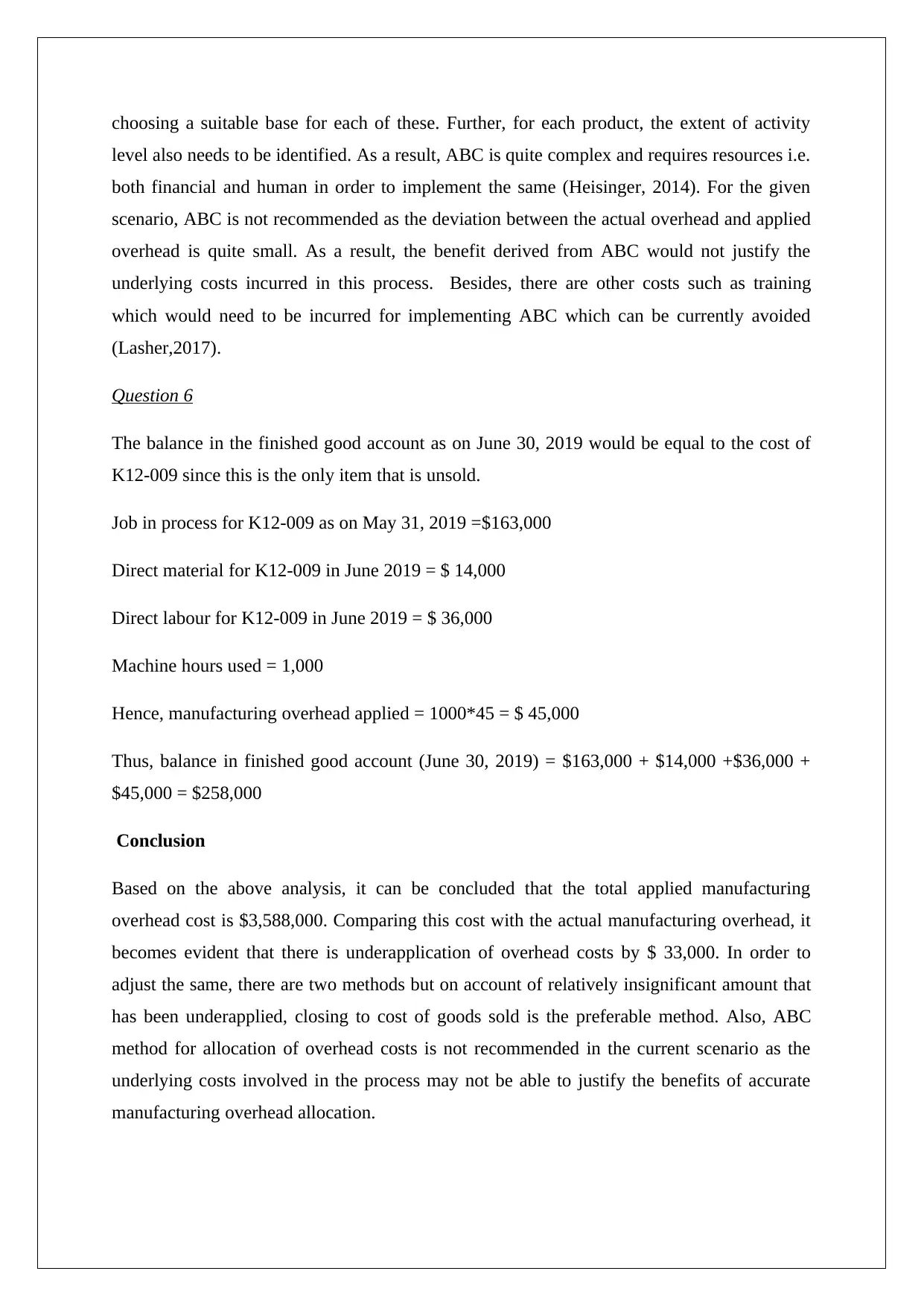
choosing a suitable base for each of these. Further, for each product, the extent of activity
level also needs to be identified. As a result, ABC is quite complex and requires resources i.e.
both financial and human in order to implement the same (Heisinger, 2014). For the given
scenario, ABC is not recommended as the deviation between the actual overhead and applied
overhead is quite small. As a result, the benefit derived from ABC would not justify the
underlying costs incurred in this process. Besides, there are other costs such as training
which would need to be incurred for implementing ABC which can be currently avoided
(Lasher,2017).
Question 6
The balance in the finished good account as on June 30, 2019 would be equal to the cost of
K12-009 since this is the only item that is unsold.
Job in process for K12-009 as on May 31, 2019 =$163,000
Direct material for K12-009 in June 2019 = $ 14,000
Direct labour for K12-009 in June 2019 = $ 36,000
Machine hours used = 1,000
Hence, manufacturing overhead applied = 1000*45 = $ 45,000
Thus, balance in finished good account (June 30, 2019) = $163,000 + $14,000 +$36,000 +
$45,000 = $258,000
Conclusion
Based on the above analysis, it can be concluded that the total applied manufacturing
overhead cost is $3,588,000. Comparing this cost with the actual manufacturing overhead, it
becomes evident that there is underapplication of overhead costs by $ 33,000. In order to
adjust the same, there are two methods but on account of relatively insignificant amount that
has been underapplied, closing to cost of goods sold is the preferable method. Also, ABC
method for allocation of overhead costs is not recommended in the current scenario as the
underlying costs involved in the process may not be able to justify the benefits of accurate
manufacturing overhead allocation.
level also needs to be identified. As a result, ABC is quite complex and requires resources i.e.
both financial and human in order to implement the same (Heisinger, 2014). For the given
scenario, ABC is not recommended as the deviation between the actual overhead and applied
overhead is quite small. As a result, the benefit derived from ABC would not justify the
underlying costs incurred in this process. Besides, there are other costs such as training
which would need to be incurred for implementing ABC which can be currently avoided
(Lasher,2017).
Question 6
The balance in the finished good account as on June 30, 2019 would be equal to the cost of
K12-009 since this is the only item that is unsold.
Job in process for K12-009 as on May 31, 2019 =$163,000
Direct material for K12-009 in June 2019 = $ 14,000
Direct labour for K12-009 in June 2019 = $ 36,000
Machine hours used = 1,000
Hence, manufacturing overhead applied = 1000*45 = $ 45,000
Thus, balance in finished good account (June 30, 2019) = $163,000 + $14,000 +$36,000 +
$45,000 = $258,000
Conclusion
Based on the above analysis, it can be concluded that the total applied manufacturing
overhead cost is $3,588,000. Comparing this cost with the actual manufacturing overhead, it
becomes evident that there is underapplication of overhead costs by $ 33,000. In order to
adjust the same, there are two methods but on account of relatively insignificant amount that
has been underapplied, closing to cost of goods sold is the preferable method. Also, ABC
method for allocation of overhead costs is not recommended in the current scenario as the
underlying costs involved in the process may not be able to justify the benefits of accurate
manufacturing overhead allocation.
Paraphrase This Document
Need a fresh take? Get an instant paraphrase of this document with our AI Paraphraser
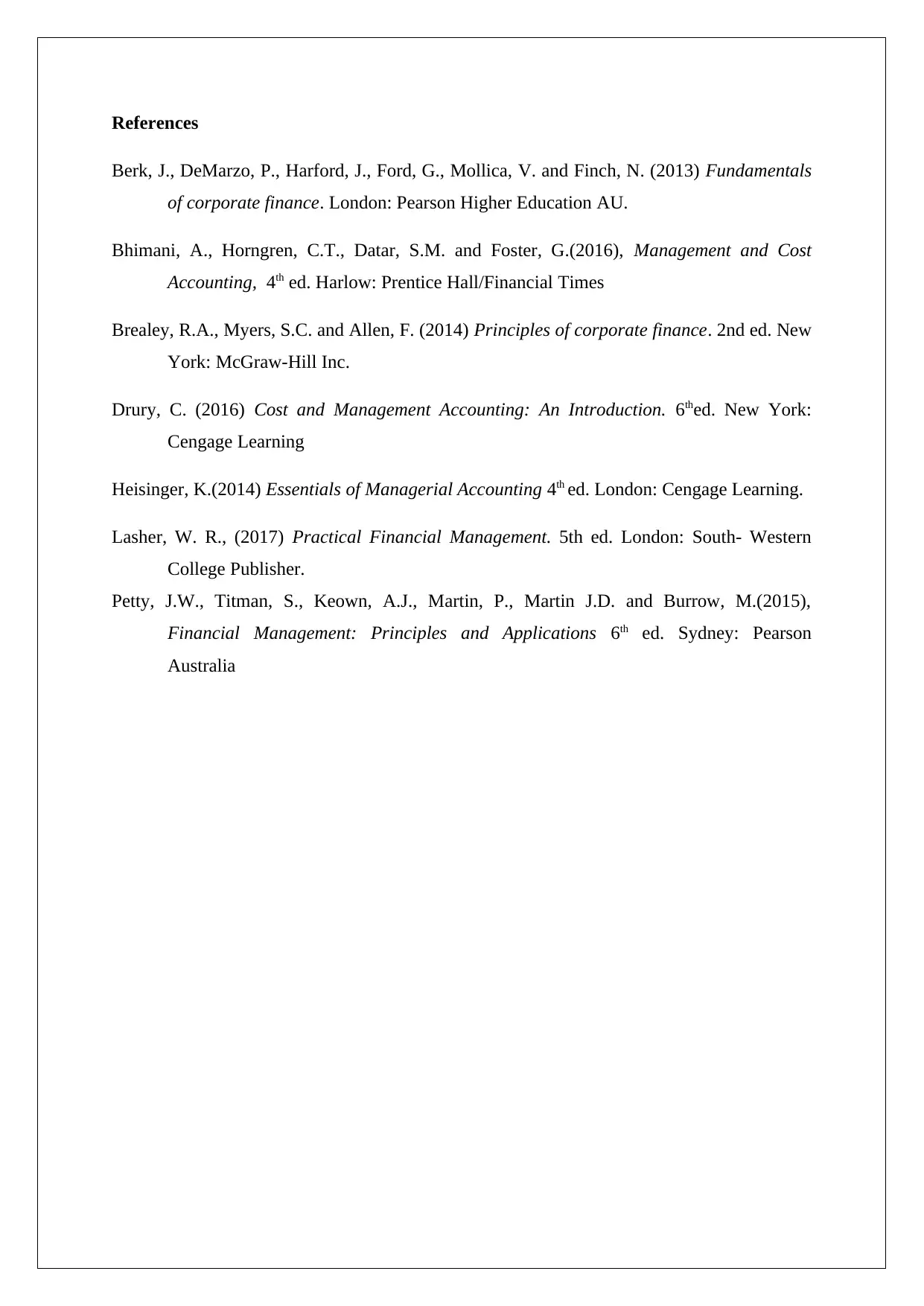
References
Berk, J., DeMarzo, P., Harford, J., Ford, G., Mollica, V. and Finch, N. (2013) Fundamentals
of corporate finance. London: Pearson Higher Education AU.
Bhimani, A., Horngren, C.T., Datar, S.M. and Foster, G.(2016), Management and Cost
Accounting, 4th ed. Harlow: Prentice Hall/Financial Times
Brealey, R.A., Myers, S.C. and Allen, F. (2014) Principles of corporate finance. 2nd ed. New
York: McGraw-Hill Inc.
Drury, C. (2016) Cost and Management Accounting: An Introduction. 6thed. New York:
Cengage Learning
Heisinger, K.(2014) Essentials of Managerial Accounting 4th ed. London: Cengage Learning.
Lasher, W. R., (2017) Practical Financial Management. 5th ed. London: South- Western
College Publisher.
Petty, J.W., Titman, S., Keown, A.J., Martin, P., Martin J.D. and Burrow, M.(2015),
Financial Management: Principles and Applications 6th ed. Sydney: Pearson
Australia
Berk, J., DeMarzo, P., Harford, J., Ford, G., Mollica, V. and Finch, N. (2013) Fundamentals
of corporate finance. London: Pearson Higher Education AU.
Bhimani, A., Horngren, C.T., Datar, S.M. and Foster, G.(2016), Management and Cost
Accounting, 4th ed. Harlow: Prentice Hall/Financial Times
Brealey, R.A., Myers, S.C. and Allen, F. (2014) Principles of corporate finance. 2nd ed. New
York: McGraw-Hill Inc.
Drury, C. (2016) Cost and Management Accounting: An Introduction. 6thed. New York:
Cengage Learning
Heisinger, K.(2014) Essentials of Managerial Accounting 4th ed. London: Cengage Learning.
Lasher, W. R., (2017) Practical Financial Management. 5th ed. London: South- Western
College Publisher.
Petty, J.W., Titman, S., Keown, A.J., Martin, P., Martin J.D. and Burrow, M.(2015),
Financial Management: Principles and Applications 6th ed. Sydney: Pearson
Australia
1 out of 5
Related Documents
Your All-in-One AI-Powered Toolkit for Academic Success.
+13062052269
info@desklib.com
Available 24*7 on WhatsApp / Email
![[object Object]](/_next/static/media/star-bottom.7253800d.svg)
Unlock your academic potential
Copyright © 2020–2025 A2Z Services. All Rights Reserved. Developed and managed by ZUCOL.





